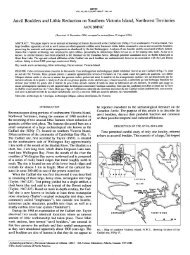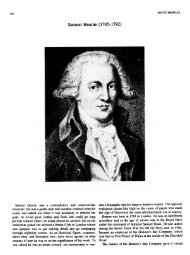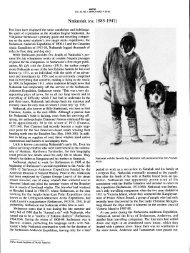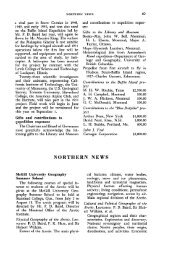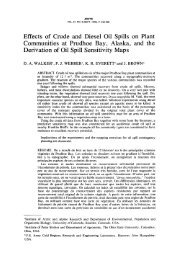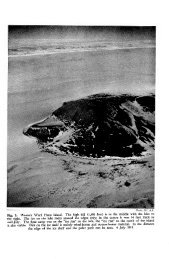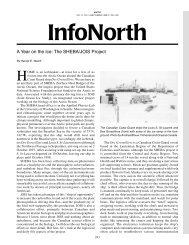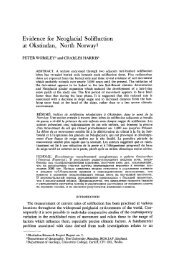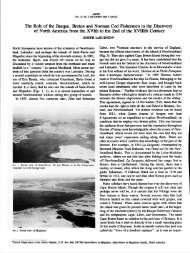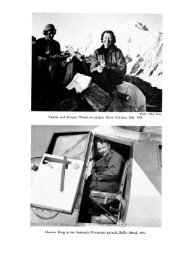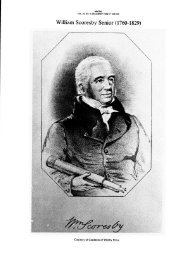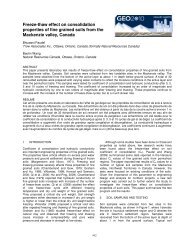A.H. JOY (1887-1932)
A.H. JOY (1887-1932)
A.H. JOY (1887-1932)
You also want an ePaper? Increase the reach of your titles
YUMPU automatically turns print PDFs into web optimized ePapers that Google loves.
558<br />
A.H. <strong>JOY</strong> (<strong>1887</strong>-<strong>1932</strong>)<br />
ARCTIC PROFILES<br />
Inspector Alfred Herbert Joy of the Royal Canadian outcrops, archaeological sites, sites of historic interest,<br />
Mounted Police is best known for a remarkable 1800-mile weather, and sea-ice conditions. His detailed remarks on<br />
(2900-km) patrol by dogsled across the heart of the Queen the numbers and migration of Peary caribou among the<br />
Elizabeth Islands in 1929. He had a keen interest in and Queen Elizabeth Islands and the long distances arctic<br />
extensive knowledge of the Arctic, its wildlife and people, hares can travel on their hind legs are of great biological<br />
and was dedicated to upholding the law and jurisdiction of interest. He also foresaw new ways of patrolling the High<br />
Canada in isolated arctic regions.<br />
Arctic, stating: “It would be possible, if necessary, I believe,<br />
A.H. Joy was born in Maulden, eight miles south of to carry on an extensive survey of the islands west of<br />
Bedford, England on ,26 June <strong>1887</strong>, where he attended Eureka sound by aeroplane.” He made important biologischool,<br />
leaving the classroom in 1899 for work as a farm cal and archaeological collections for what is now the<br />
labourer. He then travelled to Canada, enlisting in the National Museums of Canada. His collection of 700 speci-<br />
Royal North-West Mounted Police on 19 June 1909 after a<br />
short period of homesteading on the prairies. He rose<br />
mens from a Palaeo-Eskimo site was acknowledged by the<br />
Chief of the Division of Anthropology to be . . . “one of<br />
rapidly through the ranks: corporal in 1912, sergeant in the most valuable accessions that the Division has received<br />
1916, staff-sergeant in 1921, and inspector in 1927. He since I took charge of it in 1910.”<br />
thrived on the challenge of life on the northern frontiers of In 1926, Joy travelled with his assistant, Nookapeeungwak,<br />
Canada-from 1914 to 193 1, he had never spent a summer some 975 miles (1570 km) from Craig Harbour via Jones<br />
in civilization.<br />
Sound to Axel Heiberg Island in 40 days. As a preliminary<br />
After gaining valuable experience in the Mackenzie and to this trip, Joy, Constable Dersch and Nookapeeungwak<br />
Liard River regions, in 1920 he accompanied Inspector explored a new, and at times dangerous, route from Craig<br />
J, W. Phillips on a patrol by canoe, sailboat, and motor Harbour to Dundas Harbour and back, across the Devon<br />
launch to investigate a complex murder case on the Belcher Island Ice Cap. In 1927, Joy, Nookapeeungwak and Ahkeeoo<br />
Islands. In 1921, following Canada’s decision to extend made a 1300-mile (2090-km), 54-day patrol from Bache<br />
jurisdiction into the Arctic Islands, Joy was selected to Peninsula to King Christian Island and back. Once they<br />
represent the government at Pond Inlet, northern Baffin travelled steadily for 29 hours. Joy’s longest and most<br />
Island. Soon after his arrival he undertook investigation of famous patrol involved a circuit of approximately 1800<br />
the Janes murder case. Joy travelled to Cape Crauford in miles (2900 km) in 81 days from Dundas Harbour Devon on<br />
December, where he found and exhumed Janes’s body Island to Bache Peninsula, Ellesmere Island by way of the<br />
and conducted an autopsy. Later, in his capacity as coroner, following islands: Cornwallis, Bathurst, Melville, Edmund<br />
he held an inquest and gathered a jury, the accused, and Walker, Lougheed, King Christian, Ellef Ringnes, Amund<br />
witnesses from as far away as Igloolik, in addition to Ringnes, Cornwall, and Axel Heiberg. He was accompapresiding<br />
as Justice of the Peace at the trial. Following the nied by Constable Taggart and the ever-reliable Nookatrial<br />
he received a notable tribute from Mr. Justice Rivet peeungwak. The first part of this journey along the southfor<br />
his outstanding work on this case - particularly for his ern coast of Devon Island was extremely difficult.<br />
thoroughness and fairness. He had enforced the law in the Joy was a big, well-built man, who towered over his<br />
Arctic Islands for the first time.<br />
Inuit comrades, He was quiet and self-contained with a<br />
In 1924, Joy made a hair-raising attempt to cross Lancaster gift for making friends and commanding the respect of his<br />
Sound by dogsled from northern Baffh Island to test the fellows. He led by example, and was careful in giving<br />
practicabilityofcommunicatingwiththeR.C.M.P.detach- proper credit to those who had helped him. In addition to<br />
ment on Ellesmere Island. Wide leads, fast-moving ice, his skill as a horseman, marksman, and boxer, Joy was<br />
buckling pressure ice, and polar bears were among the fond of the dogs that aided him on his epic trips, and he<br />
hazards Joy and his two native assistants encountered. was an accomplished dogsled driver.<br />
Withcharacteristicdeterminationandunderstatement, Joy<br />
concluded that the trip to Ellesmere Island could be made<br />
Several geographical features have been named after<br />
in any kind of winter season - providing a return trip was<br />
Inspector Joy: Cape Joy (northern Baffin Island), Mount<br />
not necessary!<br />
Joy and Joy River (southern Baffin Island), Joy Island<br />
After 1925, when Joy took over detachments on eastern<br />
(Belcher Islands), and Joy Range (Axel Heiberg Island).<br />
Ellesmere Island (Craig Harbour, Bache Peninsula) and Joy’s end was tragic. He died at the age of 43, appar-<br />
Devon Island (Dundas Harbour), he began a series of long ently of a stroke, on the morning of the day he was to be<br />
exploratory patrols across the Queen Elizabeth Islands married in Ottawa. Major-General J.H. MacBrien, Comwhich<br />
would do credit to any great polar explorer. During missioner of the R.C.M.P., wrote his epitaph: “Inspector<br />
these trips he was able to correct errors on maps, explore Joy was a particularly fine officer, a magnificent Arctic<br />
new sled routes, make notes on wildlife, vegetation, coal traveller and his death was greatly regretted.”
ARCTIC PROFILES 559<br />
Sgt. A.H. Joy with Eskimos, 1920<br />
ACKNOWLEDGEMENTS<br />
I thank Supt. J.R. Bentham, S.W. Horrall, H. Kerfoot, H.<br />
Margetts, Col. L.H. Nicholson, A.F. Cirket, Mrs. E. Herman,<br />
and L. Adamson.<br />
FURTHER READINGS<br />
FETHERSTONHAUGH, R.C. 1938. The Royal Canadian Mounted<br />
Police. New York: Carrick and Evans.<br />
ROYAL CANADIAN MOUNTED POLICE. Commissioner’s Reports<br />
of the Royal Canadian Mounted Police (particularly the “blue books”<br />
for the years 1921-1931).<br />
STEELE, HARWOOD. 1936. Policing the Arctic. London: Jarrold’s.<br />
TAYLOR, ANDREW. 1955. Geographical Discovery and Exploration<br />
in the Queen Elizabeth Islands. Geographical Branch Memoir3 (Ottawa).<br />
C.R. Harington<br />
Paleobiology Division<br />
National Museums of Canada<br />
Ottawa, Ontario, Canada<br />
KIA OM8



